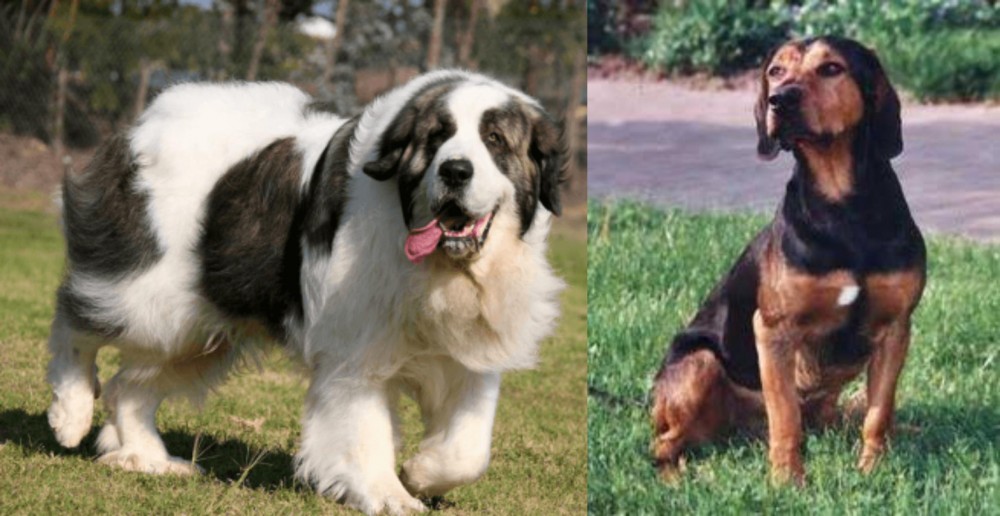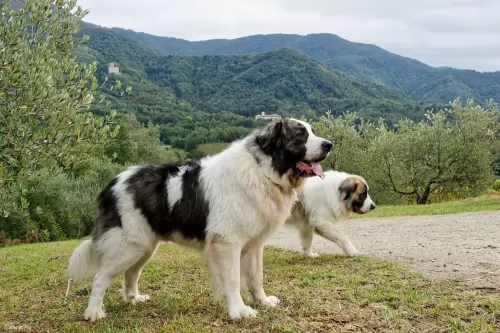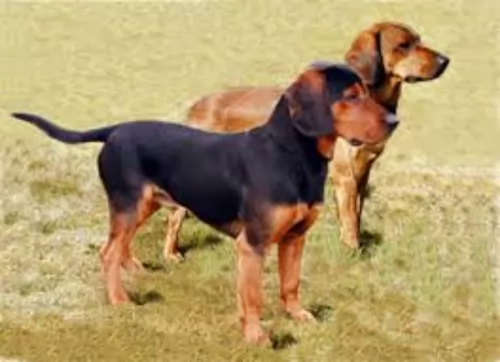 Petzlover
Petzlover Pyrenean Mastiff is originated from Spain but Tyrolean Hound is originated from Austria. Pyrenean Mastiff may grow 32 cm / 13 inches higher than Tyrolean Hound. Pyrenean Mastiff may weigh 73 kg / 161 pounds more than Tyrolean Hound. Both Pyrenean Mastiff and Tyrolean Hound has same life span. Pyrenean Mastiff may have more litter size than Tyrolean Hound. Both Pyrenean Mastiff and Tyrolean Hound requires Low Maintenance.
Pyrenean Mastiff is originated from Spain but Tyrolean Hound is originated from Austria. Pyrenean Mastiff may grow 32 cm / 13 inches higher than Tyrolean Hound. Pyrenean Mastiff may weigh 73 kg / 161 pounds more than Tyrolean Hound. Both Pyrenean Mastiff and Tyrolean Hound has same life span. Pyrenean Mastiff may have more litter size than Tyrolean Hound. Both Pyrenean Mastiff and Tyrolean Hound requires Low Maintenance.
 The Pyrenean Mastiff originates from Spain, descending from ancient livestock guardian-type dogs.
The Pyrenean Mastiff originates from Spain, descending from ancient livestock guardian-type dogs.
They have always been used as guardians, looking out for livestock and warding off predators.
When you do research you find that there is little information on the exact origins of the dog. It was only in recent years that the dog was taken out of its native region and sent to the USA, but it isn’t recognized by the AKC.
The dog was however recognized by the FCI in 1982.
 The Tyrolean Hound, also known as Tyroker Bracke or Tiroler Bracke originates from Tyrol, Austria. It seems the dog was developed in the late 1800s for hunting.
The Tyrolean Hound, also known as Tyroker Bracke or Tiroler Bracke originates from Tyrol, Austria. It seems the dog was developed in the late 1800s for hunting.
This is a scenthound that is thought to have descended from Celtic Hounds, Foxhounds and Bloodhounds in the late 1800s.
The dog is a member of the FCI’s scent hound group. The dog was recognized as its own breed in 1908, and in 2006 it was recognized by the United Kennel Club.
 This is a beautiful big dog, strong and muscular. He stands at between 75 and 82cm in height and weighs between 70 and 100kg, males and females.
This is a beautiful big dog, strong and muscular. He stands at between 75 and 82cm in height and weighs between 70 and 100kg, males and females.
He has a thick double coat which is fairly long and which also sheds regularly. The coat is essentially white in color with large markings of reddish brown, tan, grey or black.
The Pyrenean Mastiff has a large head with a black nose, small, dark eyes, floppy, medium sized ears and a long tail with lush hair growth.
Large he may be, but the Pyrenean Mastiff is a docile dog that gets on well with children as well as with other pets. He is intelligent but also strong willed and independent, making him a little bit difficult to handle if he chooses to ignore your commands.
Training and socialization will be required if you want him to be obedient and well mannered. He can do well with you as a novice pet owner, so long as you are firm, consistent, kind, patient and fair in your handling of the Pyrenean Mastiff.
Even with socialization, he tends to be wary around strangers and becomes quite protective around his human family.
He is a calm dog that doesn’t require a whole lot of exercise, but he isn’t suited to life on a small property in the city as he needs a lot of space to feel content and at ease.
 The Tyrolean Hound is a medium-sized to large dog. He stands at roughly between 43 to 50cm in height and can weigh between 20 and 27kg.
The Tyrolean Hound is a medium-sized to large dog. He stands at roughly between 43 to 50cm in height and can weigh between 20 and 27kg.
He is muscular, lean and compact. The double coat is short and smooth and can be red, tan, black or tri-colored. The ears are high set, are broad, floppy and long. The tail is long and is carried high.
Independent and intelligent the Tyrolean Hound is a hardworking dog, loving to be active. He has all the characteristics of a great pet and companion – loving, lively, intelligent, independent, easily trained and protective.
He’s the kind of dog that would suit a home with a large garden as opposed to living in the city. He is wary of strangers and has a loud bark to warn you of intruders. He has a friendly nature with his human family and makes a good playmate for children.
 These beautiful dogs have always been extraordinary guarding dogs, but he has some other excellent characteristics that make him such a great companion.
These beautiful dogs have always been extraordinary guarding dogs, but he has some other excellent characteristics that make him such a great companion.
He is a loyal, loving dog and easy to train.
You just have to think twice before you take such a large dog into your home, as he doesn’t like to be cooped up in small spaces. He will also eat a lot too.
You want to know that you can provide the Pyrenean Mastiff with all these things. If you have the means to keep such a large pet, then he will make you a splendid canine companion.
 The Tyrolean Hound is a keen hunting dog loving to be outdoors and active, requiring large grounds to be happy.
The Tyrolean Hound is a keen hunting dog loving to be outdoors and active, requiring large grounds to be happy.
Once he comes indoors he is able to settle down with his human family and have some quiet time with them.
He is loyal and loving, but you are going to have to be prepared for an active lifestyle with this skilled hunting dog of yours.
 This is a fairly healthy dog breed, particularly when you consider what a big dog he is. There are always some health concerns to watch for so that you can take steps to get your pet well again.
This is a fairly healthy dog breed, particularly when you consider what a big dog he is. There are always some health concerns to watch for so that you can take steps to get your pet well again.
There is tartar build-up on the teeth and this can lead to infection of the gums and roots of the teeth. Rotting teeth can cause pain, but more worrisome they can cause damage to the heart and kidneys as well as the dog's joints. The vet or professional pet groomers can keep your pet’s teeth clean. They can advise you on how to take care of your large pet’s teeth.
Diseases such as rabies and parvo can be prevented by means of vaccine.
You can’t afford for a big dog like this to become obese. It’s a serious disease and can put pressure on your dog’s joints and also cause back pain and digestive disorders.
Your dog can be infected with all kinds of worms and bugs such as ticks d and fleas as well as mites. Some of these parasites can be transmitted to you. Your vet can talk about preventive medication.
Gastric Dilatation and Volvulus, commonly referred to as bloat often occurs in dogs with deep chests.
The stomach twists and fills with gas,and blood to the stomach is cut off. Left unattended to, your dog can die, sometimes within half an hour. His stomach is hard and swollen, requiring immediate veterinary attention.
 Because these dogs put everything into their hunting, injuries related to hunting can sometimes plague this energetic dog.
Because these dogs put everything into their hunting, injuries related to hunting can sometimes plague this energetic dog.
Apart from that, he is robust and can live to be 12 – 14 years of age. There are one or two common dog illnesses to look out for with this dog such as hip dysplasia or ear infections.
The large, floppy ears of the Tyrolean Hound are prone to ear infections. Unlike with dogs that have erect ears, these dogs don’t have their inner ears aired and the dampness, wax and dirt cause bacteria to build up which ultimately leads to an ear infection.
The hip joint forms abnormally, leading to chronic wear and tear together with inflammation. Sometimes the dog will squeal when he gets touched around his hips. The condition can worsen and sometimes the dog even becomes lame. He will need to get to the vet for something to control pain.
 Have your pet spayed or neutered if you don’t want puppies. Spaying or neutering also decreases the likelihood of certain types of cancers.
Have your pet spayed or neutered if you don’t want puppies. Spaying or neutering also decreases the likelihood of certain types of cancers.
Nothing but a top quality diet is good enough for your pet. Commercially manufactured dog foods are a convenient means to feed your pet, and there are some excellent brands.
Look out for the ones for extra large dogs and avoid the ones with low quality ingredients. The dry kibble you give your big pet can be made more tasty when you add some homemade food to it about twice a week.
Dogs thrive on simplicity, so boiled chicken, sweet potatoes, brown rice or pasta, carrots and spinach will be wonderful for him when you chop the food up and add it into the dry kibble. Its such a tasty, wholesome treat for your pet.
Some raw meat added in occasionally will contribute to your pet’s heath. Make sure he is never without a constant supply of fresh, cool water.
Brush his coat at least twice a week. Check inside his ears for redness which could indicate an ear infection.
He’s an intelligent pet with lots of energy, so you will need to keep his mind and body active by ensuring he enjoys walks every day. He isn’t a dog that requires running with you on your jogs or cycles.
 He has a short coat and will simply require a brush twice a week. Because of the fairly large, floppy ears, he will need to have the inside of his ears checked for redness and the possibility of an ear infection.
He has a short coat and will simply require a brush twice a week. Because of the fairly large, floppy ears, he will need to have the inside of his ears checked for redness and the possibility of an ear infection.
This dog has always been used to plenty of exercise. He won’t adapt to life in the city on a tiny property. The ideal place for this dog is on a large property, preferably a farm.
Walks, hikes, swimming, ball games, hide and seek – he is a dog that can’t seem to get enough action – he wants to be in on all the action. He is intelligent and will also need mental stimulation.
If you were to buy your lean Tyrolean Hound some commercially manufactured food, you’d buy him food that was made for high energy dogs. You’d certainly want to make sure the food is of a high quality, packed with vitamins and minerals and natural ingredients.
He would also love some home-made food too. Raw meat occasionally would do him the world of good. This sort of food needs to be plain and simple such as boiled chicken, brown rice and vegetables.